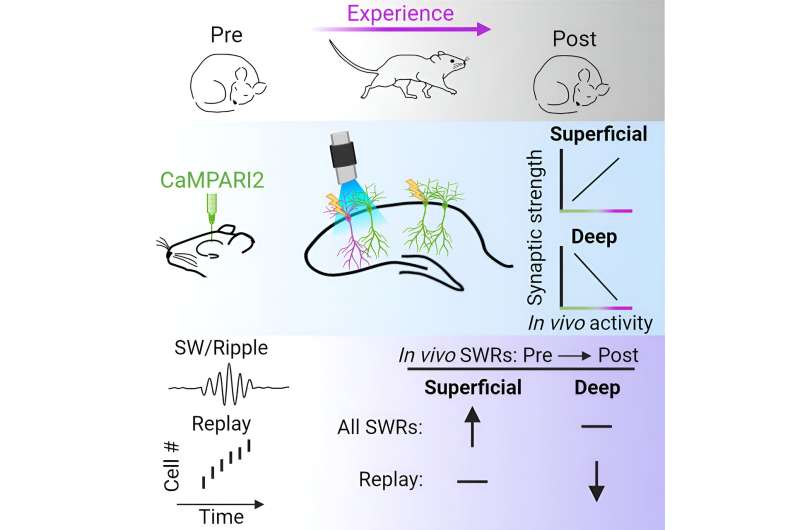This article has been reviewed according to Science X's editorial process and policies. Editors have highlighted the following attributes while ensuring the content's credibility:
fact-checked
peer-reviewed publication
trusted source
proofread
New study challenges classic tenet of memory research

Connections among one set of activated neurons in rat brains grew stronger while memories were being formed, but those in another weakened, UT Southwestern Medical Center researchers have discovered. The findings, at odds with traditional thinking about how the brain operates, provide clues into the mystery of learning and memory, processes that go awry in diseases including Alzheimer's, schizophrenia, and autism.
"This research argues that the underlying mechanisms through which memories form in the hippocampus are not as straightforward as the field once thought. It's not only about strengthening connections," said Brad Pfeiffer, Ph.D., Assistant Professor of Neuroscience at UT Southwestern and a Southwestern Medical Foundation Scholar in Biomedical Research.
Dr. Pfeiffer co-led the study published in Neuron with Lenora Volk, Ph.D., Assistant Professor of Neuroscience and Psychiatry. Drs. Pfeiffer and Volk are Investigators in the Peter O'Donnell Jr. Brain Institute at UTSW.
The hippocampus, a seahorse-shaped part of the cerebrum, has long been recognized as the primary memory-making region of the brain. Decades of research have shown that experiences an animal undergoes cause hippocampal neurons to send electrical signals to each other, altering neuronal connections known as synapses.
An adage in neuroscience is "neurons that fire together, wire together," implying that memories form when synapses strengthen between groups of activated neurons. However, Dr. Volk said, this concept has been based on studies of brain samples extracted from lab animals a significant time after they engaged in memory-forging experiences, making it challenging to link what was observed in a brain slice and what might actually happen in an intact brain.
To better understand neuronal activity, Drs. Volk and Pfeiffer, along with colleagues at UTSW, took advantage of a new technology called a calcium-modulated photo-activatable ratiometric integrator (CaMPARI). This tool causes neurons to glow green until they are activated during an experience, at which point they permanently switch from green to red, allowing the researchers to identify those neurons that may have participated in memory formation.
The researchers used CaMPARI on hippocampal excitatory neurons—which have the potential to send electrical signals to each other through synapses—in live rats. They then prompted these rats to explore a linear track, lured by chocolate milk at either end. When the researchers collected samples from the animal brains a short time later, about a third of the altered neurons glowed red, showing they had been activated by this experience.
These activated neurons were distributed nearly equally among two populations, superficial and deep neurons, named for their physical location within the brain. However, when the researchers examined synapses that had formed in these two neuronal populations, they found distinct differences: While connections had strengthened among the activated superficial neurons, those among the activated deep neurons had weakened. The researchers confirmed these findings in living rats by examining data generated by electrodes implanted in their brains.
However, this dichotomy was not as simple as it seemed, Dr. Volk said. When the researchers examined activity in the two groups of neurons in live animals after the memory-making experience, they found that the deep neurons did not only fire less than superficial neurons, but also more precisely.
"Thus," Dr. Volk said, "the deep neurons' weakened connections may not reflect global synaptic weakening, but rather synaptic refinement among the neurons most important for encoding memory."
The researchers plan to continue studying this phenomenon both in healthy animals and in models of diseases that affect information processing and memory.
Other UTSW researchers who contributed to this study were co-first authors Marcus Berndt, Ph.D., and Massimo Trusel, Ph.D., Instructor of Neuroscience; and Todd F. Roberts, Ph.D., Associate Professor of Neuroscience and an O'Donnell Brain Institute Investigator. The work was a collaborative effort among three research labs in the O'Donnell Brain Institute: the Pfeiffer Lab, Volk Lab, and Roberts Lab.
More information: Marcus Berndt et al, Bidirectional synaptic changes in deep and superficial hippocampal neurons following in vivo activity, Neuron (2023). DOI: 10.1016/j.neuron.2023.08.014



















